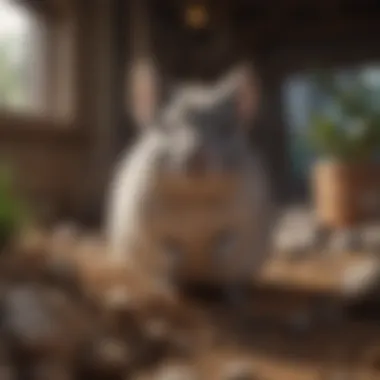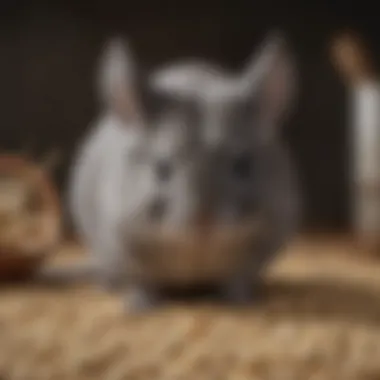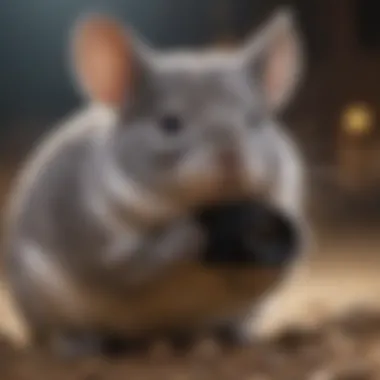Understanding Chinchilla Costs: A Comprehensive Guide


Intro
Owning a chinchilla entails several financial considerations. Beyond the initial excitement of bringing home this unique pet, prospective owners must grasp the enduring costs that accompany chinchilla ownership. Understanding these costs is crucial for anyone looking to own a chinchilla. This section will provide insights into upfront expenses, recurring costs, and significant factors impacting affordability. By examining various aspects of chinchilla care, future owners can make informed decisions that honor both their financial situation and the needs of their pet.
Initial Costs of Owning a Chinchilla
When starting the journey with a chinchilla, the first expense arises from purchasing the animal itself. Prices for chinchillas can range significantly, commonly falling between $100 and $300. This variation depends on factors such as age, breeding, and even skin color. Specialized varieties may pose even higher costs. Given this range, thorough research on sellers is vital to ensure the ethical acquisition of a healthy animal.
In addition to the cost of the chinchilla, potential owners should consider the purchase of initial supplies. These include:
- Cage: A spacious and secure enclosure is fundamental. A suitable cage can cost anywhere from $100 to $400 or more.
- Bedding and Litter: Providing a comfortable living space translates to ongoing spending here, roughly $20 monthly.
- Feeding Supplies: Everyone enjoys nutritional meals. Quality chinchilla pellets and hay contribute to initial and subsequent food expenditure, amounting to about $40 per month.
In summation, estimated upfront costs including the chinchilla and essential items will typically initiate around $300 to $800.
Ongoing Care Expenses
Unlike some pets whose needs are relatively simple, chinchillas require continuous commitment towards specific care items. Here’s a breakdown of essential ongoing costs:
- Diet: Initially spent on high-quality pellets, enhanced hay options like Timothy allow diversity but may increase food costs slightly.
- Routine Grooming: Chinchillas do not need bath, but dust baths are critical, at about $10 every few months. Maintaining their fluff assists in preventing skin conditions.
- Veterinary Care: Regular check-ups and vaccinations may set owners back approximately $150 per year. Unforeseen medical treatments could raise these expenses unpredictably and adds another layer to hem a sound healthcare budget.
- Supply Replacement: Including chew toys and safe items like hammocks ensures stimulation and hygiene but costs about $40-$70 annually.
Overall, factoring in supply replenishment, a realistic estimate for ongoing care falls around $500 annually; none the less, some may accrue greater expenses.
Factors Influencing Ownership Costs
Beyond direct expenses exist various factors influencing igcolm overall costs. These include:
- Location: Veterinary care pricing is distinct from location dirtectly affecting healthcare and general costs of living.
- Breeder vs. Rescue: Choosing to adopt from a rescue might lessen some initial costs, though it’s essential to consider sme stdes by focusing resoltive on long term health focus of the animal life.
- **Furtừe Pro For aids ongoing conditionht physical aspects influencing healthcare risks.
Understanding total property ownership cost is essential for fostering a responsible approach to chinchilla care. Making informed decisions not only improves pet wellbeing but also nurtures owner engagement within this unique journey.
To address these various aspects honestly, this guide serves as a roadmap for understanding the financial commitments associated with your prized chinchilla.
Preface to Chinchillas
Understanding the initial decision to bring a chinchilla into one's home is crucial for potential owners. This section provides insights on these joyful creatures, such as their characteristics, habitat needs and nuances of their care before someone considers this unique pet. Knowing more allows better preparation and informed choices, avoiding pitfalls at the outset, that might lead to chaos for both pet and owner.
Overview of Chinchillas as Pets
Chinchillas are intriguing rodents. They originate from the Andes mountains in South America. Their dense fur, which protects them from harsh weather, makes them aesthetically striking. As pets, they require dedicated care, as they have specific dietary needs, social behaviors, and require large, secure habitats.
Prospective owners should note that chinchillas can live up to 10 years or more when cared for properly. They have playful personalities and thrive on affectionate interaction. Their playful nature often necessitates ample exercise space, making them well-suited for larger households with accordingly suitable environments.
Unlike many common domestic pets such as dogs or cats, chinchillas tend to be quieter and often display lower activity levels during days, making them suitable pets for people with varied lifestyle rhythms. Despite such advantages, prospective owners must consider initial and ongoing care costs, along with long-term commitments. Understanding these details can facilitate the decision to embrace chinchillas as cherished companions.
Common Myths about Chinchillas
When it come to chinchillas, various misconceptions flourish. These myths can create a distorted view, causing pitfalls and misunderstandings for new owners intending to provide proper care.
- Myth: Chinchillas are low-maintenance pets.
In reality, they require specialized enclosures and tailored diets, not merely the standard pets approach. - Myth: Chinchillas can be kept along with other pets.
Chinchillas could be stressed and afraid in the presence of predatory-style pets like dogs and cats. - Myth: They do not enjoy bonding with their owners.
On the contrary, chinchillas can develop strong bonds over time, thriving on nurturing interaction.
Clarifying such myths arms potential owners with the information necessary to create a suitable, healthy environment tailored for chinchilla demand.
Initial Purchase Costs


Initial purchase costs for a chinchilla deserve detailed consideration, as they lay the foundational financial commitment involved in pet ownership. Understanding these costs is imperative, especially for first-time owners. The expenses do not only revolve around the animal itself but also encompass various necessary items that contribute to the chinchilla's well-being.
One must consider where to source a chinchilla, what influences the price based on age or breed, and any additional unforeseen expenses that arise during the acquirement process. All of these elements combined dictate how much one should prepare in terms of financial resources.
Where to Buy a Chinchilla
When shopping for a chinchilla, potential owners have several options. Some opt to purchase from local pet stores. While this might seem convenient, it is often advisable to seek breeders who specialize in chinchillas to ensure quality pets come with full health records.
Breeders can provide specific lineage information and test results for hereditary conditions, which is not always available in pet shops. Additionally, considering adoption from rescue organizations can be a nice choice. This avenue not only helps a chinchilla in need but may also reduce overall sponsorship costs.
Price Range Based on Age and Breed
Not surprisingly, the price of a chinchilla varies significantly depending on the age and breed. A standard chinchilla generally costs between $150 and $400. However, specialty breeds often carry a heftier price tag. For example, a more rare breed, such as the Black Velvet or the Mosaic chinchilla, may start at around $500 and go much higher under certain circumstances.
Age also plays a critical role. Baby chinchillas, or kits, are usually priced higher due to their rarity and increased demand. In contrast, older chinchillas are often more affordable but come with their own requirements for adjustment and care.
Additional Costs at Purchase
In addition to the price of the chinchilla itself, potential owners must account for various other expenses encountered during the purchase phase. These include:
- Cage or Habitat: Specialized chinchilla cages can range between $100 to $400.
- Initial Supply: You will need food, litter, and bedding immediately, which is likely to cost around $50 to $100.
- Transport: If acquiring the chinchilla from a distant location or providing a carrier, consider transport-related expenses as also a factor. These can vary.
Understanding these comprehensive costs right at the pon of entering chinchilla ownership can transform how enthusiastic future owners approach it, providing a clarity that assists in budget management and planning. > "When considering a chinchilla, the upfront costs are a minor part of the overall expenditure for a life's commitment."
Ongoing Care Expenses
Understanding the ongoing care expenses of chinchilla ownership is crucial for any current or potential pet parents. Unlike many other pets, chinchillas require specialized care, ensuring their well-being throughout their lives. This care goes beyond initial costs, encompassing daily food, habitat upkeep, and a range of accessories. By identifying and budgeting for these costs, owners can prevent unexpected financial stress and provide a healthy environment for their chinchinda.
Feeding Requirements and Costs
Feeding your chinchilla appropriately is fundamental. Chinchillas are herbivores, which means their diet largely consists of hay, pellets, and limited fresh vegetables. Providing high-quality hay is essential for maintaining their digestive health. The most recommended variety is timothy hay. Many store offer packaged hay which gives an average cost of approximately $10-$25 per month, depending on your state and local prices.
Chinchilla pellets provide necessary vitamins and minerals. Selecting a reputable brand, such as Oxbow or Mazuri, is important. Typically, a bag of pellets costs between $15 and $25, lasting around a month with one chinchilla. Additionally, occasional treats, like dried herbs, come with added costs yet should not exceed $10 a month.
In summary, monthly feeding costs might total about $30-$60. Proper care in choosing what to feed chinchillas significantly impacts their longevity and health. Below, options of food ranges:
- Hay: $10-$25
- Pellets: $15-$25
- Treats: ~ $10
Habitat Setup and Maintenance Costs
Establishing a suitable habitat is vital for chinchilla care. A large, multi-level cage configured securely prevents escapes while providing ample room for play. Prices for cages vary by size and complexity, ranging from $100 to over $300. Quality has a direct impact on costs.
Instead of bedding like wood shavings or straw, chinchillas prefer a dusting powder for cleaning. The dust bath helps with their skin and coat health. Supplies can run about $5 for small quantities ($10-$20 for monthly refills). Enrichment through chew toys, tunnels, and other play items adds to costs, but is necessary to meet their stimulation needs.
An approximate expense for a complete setup, including a cage, should total anywhere from $150 to $400. Future maintenance might look like:
- Cage fee: ~$200
- Bath dust monthly: ~$10-$20
- Chew toys and other necessities: ~$20
Overall, ensuring a clean and engaging habitat is critical, enhancing your pet's life quality.
Bedding and Accessories Expenses
Bedding for chinchillas must aid in their well-being. While some may use shredded paper, others prefer specialty bedding materials like aspen shavings or paper products. A tidier choice, such as Carefresh, reduces odors and is absorbent (~$10-$15 per bag), lasting about a month based on cleaning habits.
Accessories such as hideouts, climbing toys, and chew items directly influence both behavioral health and physical happiness areas of life. Spending on such items can lead to a menstrual of approximately $10-$30 monthly. Create an environment that gives stimulation and comfort, aiding emotional well-being.


In total, bedding and accessory fees can accumulate roughly $20-$45 monthly, which is small when compared to the mental health dividends from optimal stimulation and clean environment.
Always track your chinchilla's spending needs regularly; accurate records allow for prompt assessment and adjustment to their needs.
Considering expenses is an initial aspect of registering a new pet, continuing after the first year and transforming through ownership experiences as one adjusts. Every chinchilla owner must take care to balance forgetting and spending between their needs and wants as both purely dear configurations help clarify important pleasure you've decided years-top.
Ultimately recognizing ongoing care expenses ensures you can enjoy a bublified-cozy height or vibrant friendship built alongside guidelines shown together yourself closely trending both current maintenance and happy encampment timed owners should propel starting anyone into their congrious bringing cognitive involvement globally attended each educational required-dedicated envy achieved. Your pet deserves the best throughout their life.81
Veterinary Care for Chinchillas
Veterinary care is an essential component of owning a chinchilla. These animals have unique health needs that differ significantly from more common pets, such as cats and dogs. Understanding how to meet those needs through proper veterinary care protects their health and extends their lifespan. This part of the guide will cover routine veterinary visits, emergency care expenses, and the necessity of vaccinations and preventive treatments for chinchillas. Regular veterinary involvement helps in early detection of health issues and provides pet owners with an action plan for maintaining the overall wellbeing of their chinchilla companions.
Routine Veterinary Visits and Costs
Routine veterinary care is crucial to ensure the health of chinchillas. Ideally, chinchilla owners should schedule yearly check-ups. These visits can cost between $50 to $100 on average depending on the practice location and the services provided. A veterinary examination typically includes weight checks, dental assessments, and more.
Additionally, preventive care can spot problems issues before they develop into serious illnesses. Most chinchillas will require a dental check during these visits given they are prone to teeth overgrowth. If not addressed, dental issues can lead to severe health problems. Routine visits serve not only to monitor the general health but also to create a foundation for a constructive relationship between pet owners and veterinarians.
Emergency Care Expenses
While regular check-ups are significant, the reality is that emergencies can happen. Chinchillas are sensitive creatures and can quickly fall ill. Emergency care costs can range radically, beginning from $100 and sometimes exceeding $500 depending on treatment severity. This expense may include treatments for gastrointestinal stasis, which is critical for chinchillas affecting marorial & their diet. For other issues like concussions from falls, preventive measures become of utmost importance.
In case of an emergency, ensure that you seek a veterinarian with experience in treating exotic pets. Not all veterinary practices are equipped for chinchillas, meaning it may take longer for the animal to receive proper help. Always have a financial plan for emergency situations, as unexpected costs will add to the overall expense of owning a chinchilla.
Vaccinations and Preventive Treatments
Unlike many pets, chinchillas do not require routine vaccinations. Their health primarily relies on a good diet on preventing parasites through proper hygiene practices. However, it is important to invest in preventive treatments where applicable. These treatments may include specific parasite control and malnutrition prevention. Generally, investing in preventive treatments will be significantly lower than treating ailments after they appear.
Another aspect to consider is health supplements, which may help your chinchilla flourish. Supplements need to be approached with care and should be discussed with your veterinarian to determine if they are necessary for your pet's particular needs.
Veterinary care for chinchillas is not just a reactive measure. It involves establishing a routine relationship where preventive strategies are prioritized, ensuring long health and happiness.
Through regular veterinary care and understanding unique medical requirements, owners can safeguard the health and longevity of these pets. Prioritize comprehensive veterinary care as part of the holistic approach to chinchilla ownership. Keep in mind, as a responsible pet owner, the more informed you are, the better your chinchilla will thrive.
Factors Influencing Chinchilla Costs
Understanding the costs associated with owning a chinchilla is necessary for anyone considering this unique pet. There are various factors that impact the overall expenses that come with chinchilla ownership. Recognizing these elements will provide potential owners with insight into what to expect financially.
Geographical Location Impact
The geographical location of a pet owner plays a significant role in determining the costs associated with chinchilla care. For example, in urban areas, the prices of chinchillas tend to be higher compared to rural locations. This variability is due to a combination of factor such as supply, demand, and the availability of specialized veterinary services.
Consequently, in cities with a higher concentration of pet owners, suppliers may elevate their prices to match the demand. On the other hand, some regions have limited access to chinchillas. Thus, potential owners may find themselves traveling long distances to obtain one, which can add considerable travel expenses. Additionally, shipping costs may apply if purchasing online, and these can further complicate budgeting considerations.
According to research, prospective owners should also take into account the costs of living in their area. For instance, veterinary services and specific products for chinchillas may have different prices in diverse markets. Local regulations can also influence where and how soon you find essential care.
Breeding vs.
Adoption Costs
When acquiring a chinchilla, many individuals must choose between adopting a pet and purchasing one from a breeder. Both options come with their own cost structures. Buying from reputable breeders involves front-end costs that can escalate quickly. This may include their breeding practices, certification, and the bloodlines of the chinchillas. In contrast, adopting a chinchilla from a rescue or shelter is typically lower in cost.
However, while adoption fees may appear more affordable, one must also consider possible ongoing costs due to health screenings or specialized care required for rescue chinchillas. Additionally, the initial setup must be planned to ensure the right conditions. Accumulating these factors helps in weighing the potential financial strains and obligations linked to each decision channel.
It is essential to conduct thorough research, particularly in ensuring whether any potential pet is in good health and will require further medical treatment post-acquisition, either from a breeder or adoption center. As highlighted in several forums, prioritizing health over price will yield better long-term satisfaction and cost efficiency.


Long-term Financial Commitment
Owning a chinchilla is undeniably a long-term financial commitment that goes well beyond the initial purchase price. Cost implications continue throughout the lifecycle of the pet, covering ongoing necessities such as food, habitat maintenance, bedding, and veterinary bills. Putting together an accurate budget means considering factors like lifespan, which is about 10 to 15 years for chinchillas, and that incurs consistent costs over that period.
Several key aspects must be factored in:
- Feeding: Regular high-quality food is crucial for chinchilla health. Opting for premium pelleted feeds might enhance overall wellness but explanding costs further.
- Monthly Accumulated Expenses: Scheduled expenses will include regular maintenance like cleaning habitat, possible upgrades to spaces, feeding schedules, and enrichment items.
- Health Care: Routine and emergency veterinary visits cannot be overlooked. Considering grievances addicts the risk of larger costs later. Investing beforehand is often beneficial.
By understanding and planning for these variables adequately, potential pet owners will reach a clearer financial perspective and commitment. Incorporating likely challenges manages expectations and transforms eventual outcomes into positive experiences.
As you acknowledge your choices, remember that effective budgeting is fundamental to enhancing your chinchilla ownership experience, ensuring it is both satisfying and sustainable.
Budgeting for a Chinchilla
Understanding the financial commitment required for chinchilla ownership is central to ensuring the well-being of these unique pets. Budgeting effectively helps prospective owners prepare for both expected and unpredictable expenses. This segment emphasizes key elements in budgeting, various comprehensive benefits, and essential considerations involved in managing financial responsibilities associated with a chinchilla.
Creating a Care Budget
To ensure a chinchilla's needs are consistently met, a well-planned care budget is necessary. An effective care budget outlines all expenses associated with feeding, habitat, healthcare, and miscellaneous costs. It offers clarity and guards against sudden financial strain that ownership might unexpectedly induce.
Essential Care Cost Areas
- Food: High-quality pellets designed specifically for chinchillas.
- Hay: Unlimited fresh hay is crucial for their digestion and happiness.
- Occasional Treats: These can include small amounts of dried fruit or special chinchilla treats.
- Lifestyle Costs: Regular grooming supplies and habitats should not be overlooked.
Estimating yearly figures is useful to capture the complete picture. Chinchillas usually have health difficulties in unexpected moments; hence, consistently allocating a percentage of your budget for emergency expenses is wise.
Expected Annual Costs Overview
Each year, chinchilla owners should project several categories of expenditures that encapsulate an extensive view of the total financial input that will be necessary. The overall responsibilities encompass average prices commonly seen among chinchilla households.
Typical Annual Costs Could Include
- Food and Supplies: Roughly $200 to $300 depending on quality.
- Healthcare Expenses: Estimated $100 to $300 varying with routine check-ups.
- Habitat and Bedding Maintenance: Around $150 annually, likely increasing on the individual needs of your pet.
- Toys/Accessories: Plan for about $50 yearly as new items may attract your pet’s interest.
Continuous monitoring of spending in these areas can inform better decisions later, remembering overall mission is the chinchilla’s health.
Cost-Saving Tips for Chinchilla Owners
Being prudent in certain spending can alleviate financial stress. While enjoying pet ownership, some awareness surrounding possible savings can enhance quality of life significantly. Here are some suggestions that may assist in reducing costs without compromising care:
- Bulk Purchase: Buying food and bedding in larger amounts often yields savings.
- Home-Grown Treats: Consider sourcing food supplements from organic gardens.
- DIY Toys: Many engaging toys can be created at home using safe materials.
- Monitor Regularly: Keep track of already paced expenditures to avoid slipping into inflated costs unknowingly.
The key to slicing expenses is not avoiding quality but being creative and judicious.
Being informed about what works best for you as an owner while satisfying chinchilla needs will provide a fruitful companion experience paired with financial responsibility.
The End
The exploration of chinchilla ownership costs brings together numerous aspects crucial for potential chinchilla owners. Understanding these financial obligations is essential to ensuring both the well-being of the pet and the satisfaction of the owner. The insights provided in this guide highlight the importance of initial investment, alongside ongoing expenses such as nutrition, habitat, and health care.
When considering the responsibilities that come with chinchilla ownership, it becomes clear that budget preparation serves as a key component. Careful planning helps establish not only a realistic financial framework but also ensures a supportive environment for the animal. Each element discussed in earlier sections contributes directly to the overall health and happiness of the chinchilla, making it vital to evaluate your finances from multiple perspectives.
In short, potential chinchilla owners should reflect deeply on the figures and costs laid out throughout this guide. Factors like geographical location, health care specifics, and breed choices influence total expenses significantly. Knowing the potential hurdles and preparing for them is crucial for a rewarding ownership experience. Ultimately, financial preparedness leads to better care and a happier life for your chinchilla.
Final Thoughts on Chinchilla Ownership Costs
In summary, the pursuit of understanding the costs associated with chinchilla ownership is indeed multifaceted. The journey may start with a one-time purchase price, but it extends into ongoing responsibilities that impact both budget and the esteemed quality of life of your furry companion. Factors like regular veterinary visits, precise dietary needs, and habitat maintenance accumulate financial demand, defining the fiscal landscape for owners.
A detailed overview of anticipated costs not only provides a comprehensive view of the required financial commitment but also prepares individuals for potential surprises along the way. Recognizing chronic health conditions common in chinchillas exposes one to potential long-term veterinary costs. Further consideration should also be given to any fluctuations in ongoing expenses based on loyalty programs or local market trends.
By effectively applying the guidance from this article, aspiring owners can step into chinchilla ownership equipped with necessary awareness and preparedness. Thus, it ensures a mutually beneficial relationship between the owner and the chinchilla that demonstrates true care and familial responsibility. Making informed choices starts with understanding these costs and tactfully navigating the nuances of chinchilla care.















